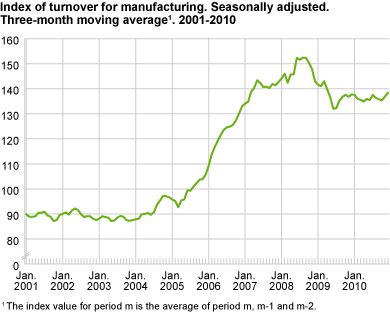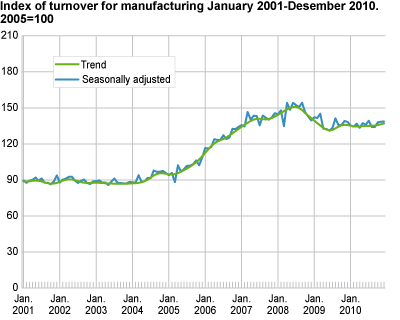Content
Published:
This is an archived release.
Manufacturing turnover varies by industry
The total turnover in Norwegian manufacturing was almost unchanged from 2009 and 2010. However, it reveals significant differences in turnover among the industrial groupings, and that they are in rather different phases of the economic cycle.
Overall, the manufacturing industry had a stable development in 2010 and ended up almost unchanged compared to 2009. Turnover within the export market increased by 3.7 per cent, while the home market fell by 2.8 per cent, see Statistics on external trade in goods . Development among the industrial groupings showed that while some have recovered from the financial crisis others have had a strong fall in turnover in 2010.
Higher turnover increase for metals and basic chemicals in 2010
Basic metals had an increase in turnover of 28.1 per cent in 2010. The biggest increase is found in non-ferrous metals, where products such as aluminium and nickel have contributed strongly. The reason is both a larger production volume, see the index of production , and a higher price, see producer price index . The increased demand for these materials and their derivatives is partly due to the rapid economic recovery in China after the financial crisis.
Turnover also increased within the grouping refined petroleum, chemicals and pharmaceutical, which went up by 15.3 per cent, showing a clear recovery from the fall in 2008 and 2009. This development can partially be explained by the improved market conditions for the Norwegian industrial solar industry.
Industries with reduced turnover in 2010
Machinery and equipment fell by 17.1 per cent in 2010, in both the export and home markets. This is a result of less activity in the ship building industry in Norway and abroad, which had a significant effect on this industry as it is an important subcontractor for the ship industry, see Statistics on external trade in goods .
Building of ship and oil platforms went down by 11.6 per cent. This industry had already secured a significant amount of orders and contracts before the crisis hit, and this has helped the industry to continue its deliveries and maintain the level of turnover during the difficult period. Nevertheless, the turnover for this industry fell in 2010 compared to 2009. It is important to note that the level of turnover for this industry is still at a historically high level.
Food products had a fall of 3.6 per cent in turnover compared to 2009.
Increased turnover last quarter 2010
Seasonally-adjusted figures showed that total manufacturing turnover increased by 1.9 per cent in the fourth quarter of 2010. Refined petroleum, chemicals and pharmaceutical went up 33 per cent. There was also increased turnover within building of ships and oil platforms, by 5.7 per cent, and by 5.6 per cent in basic metals.
Conversely, industries with decreased turnover were fabricated metal products, and machinery and equipment by 8.8 and 7.2 per cent respectively.
Norway and the euro area
Unadjusted figures show that there was a 4.7 per cent increase in Norwegian manufacturing turnover from November 2009 to November 2010. Manufacturing turnover in the euro area went up 13.8 per cent in the same period, according to figures published by Eurostat . These figures must be considered in relation to the fact that the decline in Norwegian industry was not as pronounced as in the EU countries, and had a different course due to differences in the structure of industry.
| Original series.1
January-Desember 2010 |
Changes in per cent. January-Desember 2009- January-Desember 2010 |
Original series.1
Desember 2010 |
Changes in per cent. Desember 2009- Desember 2010 |
Changes in per cent. Seasonally adjusted. July 2010-September 2010- October 2010-Desember 2010 |
|||||||||||||||||||||||||||||||||||||||||||||||||||||||||||||||||||||||||||
|---|---|---|---|---|---|---|---|---|---|---|---|---|---|---|---|---|---|---|---|---|---|---|---|---|---|---|---|---|---|---|---|---|---|---|---|---|---|---|---|---|---|---|---|---|---|---|---|---|---|---|---|---|---|---|---|---|---|---|---|---|---|---|---|---|---|---|---|---|---|---|---|---|---|---|---|---|---|---|---|
| The overall turnover | 1 483 089 | 5.3 | 144 387 | 14.0 | 10.6 | ||||||||||||||||||||||||||||||||||||||||||||||||||||||||||||||||||||||||||
| Extraction and related services | 562 204 | 5.8 | 57 462 | 22.0 | 18.3 | ||||||||||||||||||||||||||||||||||||||||||||||||||||||||||||||||||||||||||
| Manufacturing, mining and quarrying | 766 511 | -0.4 | 66 088 | 0.0 | 1.8 | ||||||||||||||||||||||||||||||||||||||||||||||||||||||||||||||||||||||||||
| Domestic market | 483 899 | -2.8 | 42 918 | -2.3 | 2.2 | ||||||||||||||||||||||||||||||||||||||||||||||||||||||||||||||||||||||||||
| Export market | 282 614 | 3.8 | 23 170 | 4.4 | -7.0 | ||||||||||||||||||||||||||||||||||||||||||||||||||||||||||||||||||||||||||
| Electricity, Gas and Steam Supply | 154 374 | 44.2 | 20 837 | 55.0 | 14.1 | ||||||||||||||||||||||||||||||||||||||||||||||||||||||||||||||||||||||||||
| Main industrial groupings | |||||||||||||||||||||||||||||||||||||||||||||||||||||||||||||||||||||||||||||||
| Intermediate goods | 333 736 | 8.9 | 28 037 | 9.7 | 0.9 | ||||||||||||||||||||||||||||||||||||||||||||||||||||||||||||||||||||||||||
| Capital goods | 229 635 | -11.7 | 20 108 | -13.2 | -1.6 | ||||||||||||||||||||||||||||||||||||||||||||||||||||||||||||||||||||||||||
| Consumer goods | 195 031 | -2.2 | 16 491 | -3.2 | -1.8 | ||||||||||||||||||||||||||||||||||||||||||||||||||||||||||||||||||||||||||
| Energy goods | 724 686 | 12.8 | 79 751 | 31.0 | 23.6 | ||||||||||||||||||||||||||||||||||||||||||||||||||||||||||||||||||||||||||
| 1 | NOK million. |
Interpretation of seasonally-adjusted figuresIn order to facilitate the interpretation of the short-term development, statistics on turnover publishes three-month moving averages of the seasonally-adjusted figures. We normally compare the latest non-overlapping three-month periods (for instance September to November compared with June to August). |
The relationship between production and turnoverThe development in the turnover can be related to changes in both volume and prices in the different industries. Production to stocks and sales from stocks can also happen. Reporting during large deliveries of capital goods can contribute to differences in the development in the index of production and the statistics on turnover. |
New table in StatBankFrom November 2010, series on annual figures are published in the StatBank (table 08534). Annual figures are calculated as the arithmetic mean of the unadjusted monthly figures. |
Tables
Find more figures
Find detailed figures from Turnover in oil and gas, manufacturing, mining and electricity supply
Additional information
The variation in manufacturing turnover can be related to changes in volume and price indices in different industries and also production to stocks and sales from stocks.
Contact
-
Robert Skotvold
E-mail: robert.skotvold@ssb.no
tel.: (+47) 40 90 24 44
-
Anne Karin Linderud Haugen
E-mail: anne.karin.linderud.haugen@ssb.no
tel.: (+47) 91 88 19 76


